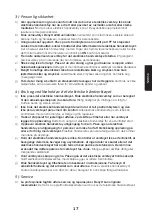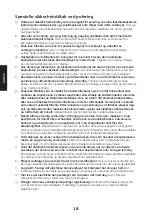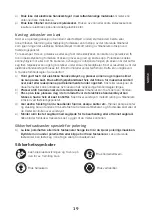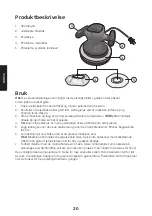
EN
G
LI
S
H
5
Special safety warnings concerning the use of polishing tools
a)
This power tool is solely intended for the purpose of polishing. Read all safety
warnings, instructions, illustrations, and specifications provided with this tool.
Failure to
adhere to all of the following instructions can result in electric shock, fire or serious injury.
b)
Operations such as grinding, sanding, wire brushing, polishing or cutting-off are
not recommended to be performed with this power tool.
The use of this power tool to
perform tasks for which the tool was not intended, can lead to danger and personal injury.
c)
Do not use accessories which are not specifically designed and recommended by
the tool manufacturer.
Even if the accessory can be attached to your power tool, there is no
guarantee that it can be used safely.
d)
The accessory’s rated speed must at least correspond to the power tool’s maximum
rated speed.
Accessories which rotate faster than their rated speed can break and shatter.
e)
The accessory’s outer diameter and size must fall within the rated capacity of your
power tool.
Using the incorrect size of accessory could render the safety features of
the power tool inoperable and cause you to loose control of the power tool.
f)
The spindle size of the wheels, flanges, and backing plates or other accessories must
fit the spindle on your power tool correctly.
Ill-fitting/incorrectly sized accessories will end
up out of balance, vibrate violently, and may lead to loss of control over the power tool.
g)
Do not use damaged accessories. Inspect the accessory and make sure there are no
splits or cracks in the grinding wheels; cracks or wear and tear on the backing plates,
or loose or torn bristles on the steel brush wheels. If you drop your power tool or
accessory, check for damage. If the accessory is damaged, use a new/undamaged
accessory. After inspecting the tool and attaching an accessory, keep yourself and
others outside of the power tool’s danger zone and let it run at full speed for one
minute.
Damaged accessories will normally break during this test period.
h)
Wear personal protective equipment. Depending on how you use the machine; use
a visor/face protection or safety glasses. If necessary use a mask, ear protection,
gloves, and apron/work clothing to protect you from small shards of metal or splinters
from the work object.
The eye protection you use must be able to protect against flying
debris produced in different working positions. The breathing protection should be able to
filter any particles produced by the work. Prolonged exposure to high levels of noise can
result in hearing damage.
i)
Keep bystanders at a safe distance from the work area. Everyone who visits the place
of work must wear personal protective equipment.
Debris from the workpiece or from
a damaged accessory can fly off and injure people outside of the immediate work area.
j)
Only hold the power tool by its insulated grip when working in positions where the cut-off
wheel might possibly cut through hidden cables or its own mains lead.
Cut-off wheels
which come in contact with an electric cable can electrify metal parts of the power tool and
subject the user to an electric shock.
k)
Position the mains lead well away from the rotating accessory.
If you lose control,
the lead can be sliced through or become entangled and pull your hand or arm into
the rotating accessory.
l)
Never put the power tool down before the accessory has completely stopped rotating.
The rotating accessory can become stuck in the material resulting in loss of control.
m)
Do not run the power tool when you are carrying it.
Unintentional contact with the rotating
accessory can cause clothing to become caught and pull the tool towards your body.
n)
Regularly clean the motor’s ventilation ports.
The motor’s fan pulls in all types of dust
through the outer casing and any build up of collected metal dust can lead to possible
electrical hazards.
o)
Do not use the power tool near flammable materials.
Sparks can easily ignite flammable material.
p)
Do not use accessories which require liquid coolants.
The use of water or other liquid
coolants can result in electric shock or electrocution.
Summary of Contents for 18-3578
Page 2: ...2...






































